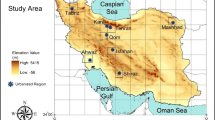Abstract
In the study, main purpose was to determine the effect of population growth along with the increase in urbanisation, motor vehicle use and green area amount on the temperature values using a 55-year data set in Erzurum, which is hardly industrialised, and one of the coldest cities with highest elevation in Turkey. Although the semi-decadal increases, means of which are 0.1°C for mean, minimum and maximum temperatures, are not clear enough to make a strong comment even in the lights of figures or tables, it was found as the result of the statistical analysis that population growth and increases in the number of vehicles, the number of buildings and the green area amount in the city have no significant effect on mean temperatures. However, the relationships between population growth and maximum temperature; and the number of vehicles and minimum temperature were found to be statistically significant.
Similar content being viewed by others
References
Anonymous (2004). Environment state report of the district of Erzurum p. 209. Erzurum: Environment and Forest Institution of Turkish State Erzurum Governorship.
Azar, E., & Burton, J. (1986). International conflict resolution: Theory and practice. Sussex: Wheatsheaf Books.
Brandsma, T., Können, G. P., & Wessels, H. R. A. (2003). Empirical estimation of the effect of urban heat advection on the temperature series of De Bilt (the Netherlands). International Journal of Climatology, 23(7), 829–845.
Cicek, I., & Turkoglu, N. (2005). Urban effects on precipitation in Ankara. Atmosfera, 18(3), 173–187.
Chung, U., Choi, J., & Yun, J. I. (2004). Urbanization effect on the observed change in mean monthly temperatures between 1951–1980 and 1971–2000 in Korea. Climatic Change, 66(1–2), 127–136.
Hardegree, L. C. (2006). Spatial characteristics of the remotely-sensed surface urban heat islands in Baton Rouge, LA: 1988–2003 (p. 121). Dissertation, Doctor of Philosophy, Graduate Faculty, Louisiana State University and Agricultural and Mechanical College, Department of Geography and Anthropology.
Jauregui, E. (1997). Heat island development in Mexico City. Atmospheric Environment, 31(22), 3821–3831.
Jauregui, E. (2005). Possible impact of urbanization on the thermal climate of some large cities in Mexico. Atmosfera, 18(4), 247–248.
Jin, M., Dickinson, R. E., & Zhang, D. L. (2005). The footprint of urban areas on global climate as characterized by MODIS. Journal of Climate, 18(10), 1551–1565.
Karl, T. R., Diaz, H. F., & Kukla, G. (1988). Urbanization: Its detection and effect in the United States climate record. Journal of Climate, 1(11), 1099–1123.
Kongar, E. (1976). A survey of familial change in two Turkish gecekondu areas. In J. G. Peristiany (Ed.) Mediterranean family structures (pp. 205–218). Cambridge: Cambridge University Press.
Kukla, G., Gavin, J., & Karl, T. R. (1986). Urban warming. Journal of Climate and Applied Meteorology, 25(9), 1265–1270.
Meyerson, F. A. B. (1998). Population, carbon emissions, and global warming: The forgotten relationship at Kyoto. Population and Development Review, 24, 115–130.
Meyerson, F. A. B. (2002). Population and climate change policy. Chapter 9. In S. Schneider, et al. (Ed.) Climate change policy. Washington, D.C: Island Press.
Oke, T. R. (1973). City size and the urban heat island. Atmospheric Environment, 7(8), 769–779.
Oke, T. R. (1982). The energetic basis of the urban heat-island. Quarterly Journal of the Royal Meteorological Society, 108(455), 1–24.
Oke, T. R. (1993). Global change and urban climates (pp. 123–134). In Proceedings of 13th International Congress Biometeorology, Calgary, Canada, 12–18 September.
Small, C. (2004). Global population distribution and urban land use in geophysical parameter space. Earth Interactions, 8(8), 1–18.
Robaa, S. M. (2003). Urban–suburban/rural differences over Greater Cairo, Egypt. Atmosfera, 17(3), 157–171.
Stallings, J. A. (2004). Characteristics of urban lightning hazards for Atlanta, Georgia. Climatic Change, 66(1–2), 137–150.
Stanhill, G. J., & Kalma, D. (1995). Solar dimming and urban heating at Hong Kong. International Journal of Climatology, 15(8), 933–941.
Tayanc, M., & Toros, H. (1997). Urbanisation effects on regional climate change in the case of four large cities in Turkey. Climatic Change, 35(4), 501–524.
Toy, S., Yilmaz, S., & Yilmaz, H. (2007). Determination of bioclimatic comfort in three different land uses in the city of Erzurum, Turkey. Building and Environment, 42(3), 1315–1318.
Unger, J. (1999). Urban–rural air humidity differences in Szeged, Hungary. International Journal of Climatology, 19(13), 1509–1515.
Viterito, A. (1989). Implications of urbanization for local and regional temperatures in the United States. In J. C. Topping Jr. (Ed.) Coping with climate change. Washington, DC: Climate Institute.
Xian, G., & Crane, M. (2005). Evaluation of urbanization influences on urban climate with remote sensing and climate observations. In Proceedings of the ISPRS joint conference 3rd International Symposium Remote Sensing and Data Fusion Over Urban Areas (URBAN 2005) 5th International Symposium Remote Sensing of Urban Areas (URS 2005) Tempe, AZ 14–16 March 2005. Vol. XXXVI, Part 8/W27.
Yilmaz, S., Toy, S., Irmak, M. A., & Yilmaz, H. (2007). Determination of climatic differences in three different land uses of the city of Erzurum, Turkey. Building and Environment, 42(4), 1604–1612.
Zhou, L. M., Dickinson, R. E., Tian, Y. H., Fang, J. Y., Li, Q. X., Kaufmann, R. K., Tucker, C. J., & Myeni, R. B. (2004). Evidence for a significant urbanization effect on climate in China. Proceedings of the National Academy of Sciences of the United States of America, 101(26), 9540–9544.
Author information
Authors and Affiliations
Corresponding author
Rights and permissions
About this article
Cite this article
Yilmaz, S., Toy, S., Demircioglu Yildiz, N. et al. Human population growth and temperature increase along with the increase in urbanisation, motor vehicle numbers and green area amount in the sample of Erzurum city, Turkey. Environ Monit Assess 148, 205–213 (2009). https://doi.org/10.1007/s10661-007-0151-z
Received:
Accepted:
Published:
Issue Date:
DOI: https://doi.org/10.1007/s10661-007-0151-z




